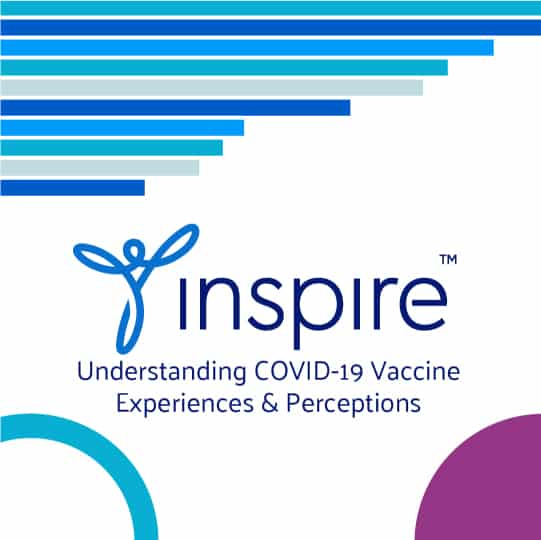Menaced by COVID-19, Susceptible Individuals Counter with Vaccine Acceptance

By Kathleen Hoffman, PhD, MSPH
“The sickest I’ve ever been!” wrote a participant in Inspire’s COVID-19 HealthJourney survey about surviving COVID-19. Another went into greater detail when asked to share their COVID-19 story.
I’ve had systemic lupus (SLE) and Discoid Lupus for 25 years. I’ve been on Hydroxychloroquine since my diagnosis. [In March] I woke with a strep-like sore throat, high fever, migraine, my body was in horrible pain. I called the doc. After being masked, gloved and gowned I was whisked into an isolated room, handled like I had the plague. I began having trouble breathing, doc started me on an inhaler and nebulizer. Was told to get a peak flow meter. After a week of monitoring, my doc switched me to 2 different Inhalers. Never really fe[lt] like I was getting enough air. All through this, my doctor couldn’t see me. My only recourse was online virtual visits sending daily peak flow charts. I got a pulse oximeter. My oxygen saturation was 86. That warranted another virtual visit. I’m put on prednisone and antibiotics along with the inhalers. Meanwhile, I’m in bed all day with intermittent high fever, constant horrible pain everywhere, migraine, nausea, dizziness. Can’t shower alone. Can’t walk across the room. There were weeks of being terrified I’m going to die and days I’m scared I won’t die and will have to live like this forever. I lost my sense of smell and taste. Pink eye set in. It was 4.5 weeks since my first fever, when it finally broke. After 7 days fever-free, I was “recovered.” Fast forward to today, a 1 year later, I’m still having trouble breathing. Yesterday I ventured to the mailbox and feared I wouldn’t make it back. I have a constant migraine and am exhausted. A shower and I’m down for 2 or 3 days. My sense of smell and taste have not returned. Hopefully it will. I wonder, if I had gone to the hospital would I have recovered faster or would I have died from being exposed to more strains or from the vent? I don’t think I’ll ever know. I’ve been told by all my docs not to be around people until the pandemic is over because some of their high risk patients have gotten covid a 2nd time. One said if I get it a 2nd time, I will not live through it.
Almost 30,000 (29,983 as of March 27) at-risk individuals have completed Inspire’s COVID-19 HealthJourney survey. The survey obtained information not only on disease exposures and long-term COVID, but also on people’s perceptions, experiences, symptoms and access to the vaccine. Immunosuppressed people living with breast cancer, sarcoidosis, Ehlers Danlos Syndrome, Charcot-Marie-Tooth and 302 other conditions completed the survey. Inspire has created an interactive Tableau dashboard (updated daily) to share data and stories with Inspire’s members, researchers and the general public. If you need a “how-to” on using the dashboard, click here.
Vaccine Interest
Having read, heard or endured the terrible experiences of COVID-19, may have been enough to motivate more at-risk individuals to get the vaccine. Eighty-two percent of respondents (24,586) intend to get (or have already gotten) the vaccine. This percentage (consistent since February) is comparatively higher than the general population’s intentions (69 percent) obtained in February by Pew Research.1
Thirty-three percent (9,894) people have already gotten the vaccine, bringing the world a little closer to herd immunity. Fewer are disinclined to obtain the vaccine (18 percent) than Pew Research’s cohort (31 percent). Of those at-risk people who were definitely not going to get the vaccine (10 percent), 77 percent also do not get the flu shot. The other 8 percent are more accepting of the flu vaccine: 46 percent of those who are not sure (5 percent) and 58 percent of those who are probably not getting the COVID-19 vaccine (3 percent) do not get the flu vaccine.
Of the 5 percent who answered “I’m not sure” about getting the vaccine, 71 percent said that they did not feel they had gotten enough information about COVID-19 and the COVID-19 vaccine in the media. One of the concerns of people who are not getting vaccinated is the misunderstanding that they will get COVID-19 from the vaccine (8 percent).
Ethnicity
Six hundred and ninety-one African Americans completed Inspire’s survey thus far. Seventy-eight percent say they plan to get the vaccine. Again, this is higher than the 61 percent of African American’s in Pew’s cohort.1 Twenty-two percent are hesitant (not sure, probably not or definitely not) about getting the vaccine. However, 29 percent had obtained the vaccine already.
Of the 776 Hispanic/Latinx who completed the survey, 84 percent have either already obtained the vaccine, say they will definitely get it, have tried to get it or say they probably will get it. This is again a higher rate than Pew’s cohort (70 percent).1
Mask Wearing
Three thousand and thirty-three respondents said that they never, rarely or only sometimes wear a mask in public. Of these, 42 percent (1289) said they would not obtain the vaccine. Seventy percent of these feel that the media coverage of COVID-19 and the vaccine has not been scientifically accurate.
Thirteen percent of non-mask wearers have already gotten their vaccine.
Adverse Event Experiences with the Vaccine Among People with Chronic Conditions
During the regulatory trials, for people getting the Pfizer-BioNTech vaccine, 79 percent had adverse reactions like swelling, redness, pain, itching, or other reaction at the injection site on their first shot. Fifty-nine percent also experienced general or systemic reactions–the list includes muscle/body aches, vomiting, joint pain, headache, fever, fatigue/tiredness, diarrhea, chills, abdominal pain, nausea, or other. During their booster shot three weeks later, 73 percent had a local reaction around the injection site and 70 percent had a general or systemic reaction.2 Moderna’s vaccine clinical trial data revealed that 84 percent of people had a local reaction on their first shot, 55 percent had a general reaction. For the Moderna booster four weeks later, 89 percent dealt with local adverse events and 79 percent of the general population had body wide reactions.3
These trials did not include people with pre-existing chronic conditions. Inspire’s research provides self-reported details of the experiences of at-risk cohorts with the two vaccines.
One individual with lung cancer felt side effects from the vaccine and detailed what happened over this past year.,
First Covid shot was just arm pain, redness and swelling. After the second shot it was fever, chills, body ache x 2 days. I was diagnosed with cancer during the pandemic. Nobody could visit with doctors. Doctors’ appt. took forever to happen. So there was delay in diagnosing and treating the cancer. Now here I am getting treatment, but if I need hospitalization, no one can visit. Very lonely with Covid.
Digging deeper into the experiences of individuals with chronic conditions, one thousand four hundred and fifty-five women and men with advanced and early breast cancer answered the survey. Eighty-four percent plan to get the vaccine and almost 40 percent have already gotten it. Of the 455 who had gotten the vaccine, 69% reported first shot injection site adverse events, 40 percent general body wide side effects and for their booster shots, 68 percent had injection site reactions while 60 percent experienced general systemic reactions.
Three thousand three hundred and eighty people with osteoporosis answered the survey. Eighty-seven percent wanted to get the vaccine. Of those who took the vaccine in the US (1211) 55 percent took the Moderna vaccine while 45 percent had the Pfizer. Seventy-three percent had adverse events around the injection site from their first shot with 44 percent having a systemic reaction (muscle/body aches, vomiting, etc). Of those that had their booster, 74% had at least one injection site response and 68% had systemic responses.
Of the 222 individuals with Ehlers Danlos Syndrome who obtained the vaccine, more people experienced reactions to the first shot than those in the general population clinical trial: 86% described at least one injection site response from the first vaccine, and 64% had systemic reactions. The percentage of those detailing injections site and systemic reactions with their booster shot also were higher than clinical trials: 94% had an injection site reaction and 81% had systemic reactions.
Charcot-Marie-Tooth disease is a rare hereditary condition. The Hereditary Neuropathy Foundation has a support community on Inspire. Fifty-two people with Charcot-Marie-Tooth syndrome reported obtaining the vaccine in Inspire’s survey. Seventy-nine percent had first shot injection site reactions while 58 percent also had generalized reactions. The booster shot caused 67 percent to have injections site reactions and 80 percent systemic reactions.
One individual with sarcoidosis wrote of their reaction to the vaccine,
There is that fear of a reaction to the vaccines for all of us who have Sarcoidosis or other autoimmune diseases. I was one of them. I have received both doses of the Pfizer vaccine. My body is triggered by over exercise, vaccines and so on. No reaction from either dose. Play it safe, trust the science.
Access to Vaccines
Not only are there stories and data about having COVID-19, getting the vaccine, being diagnosed with chronic conditions during the pandemic but there are also stories about access to the vaccine.
I don’t believe vaccines are being distributed fairly. No one is there to properly regulate the distribution in each facility. People I know who aren’t in the current priority groups have received the vaccine. I’m given the run-around by clinics & websites on how to set an appointment. Employers & Physicians are hoarding the vaccines from those who truly qualify & need it the most. So many stories from the media are not adding up.
There’s so much to review and find in Inspire’s COVID-19 HealthJourney Interactive dashboard.
Inspire offers a trusted and vital community to patients and caregivers. Our goal with this blog, this website and our content is to provide the life science industry access to the true, authentic patient voice. In so doing, we support faithful operationalization of patient-centricity. Take a look at our case studies, eBooks and news outlet coverage.
References:
1Funk, C. & Tyson, A. (March 5, 2021). Growing Share of Americans Say They Plan To Get a COVID-19 Vaccine – or Already Have https://www.pewresearch.org/science/2021/03/05/growing-share-of-americans-say-they-plan-to-get-a-covid-19-vaccine-or-already-have/
2FDA Briefing Document: Vaccines and Related Biological Products Advisory Committee Meeting, December 10, 2020, Pfizer-BioNTech COVID-19 Vaccine, fda.gov/media/144245/download (accessed February 2, 2021)
3FDA Briefing Document: Vaccines and Related Biological Products Advisory Committee Meeting, December 17, 2020, Moderna COVID-19 Vaccine, fda.gov/media/144434/download (accessed February 2, 2021)








